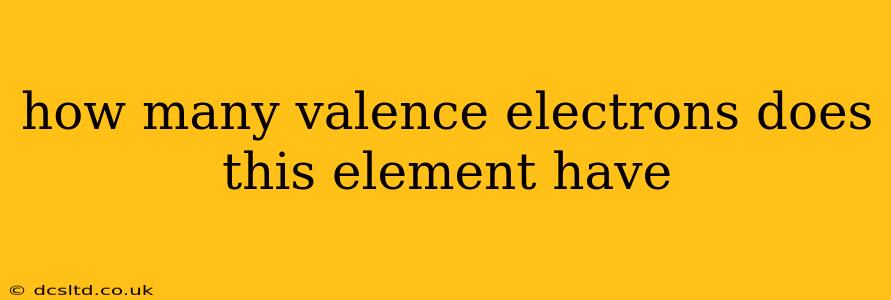How Many Valence Electrons Does This Element Have? A Guide to Understanding Valence Electrons
Determining the number of valence electrons an element possesses is crucial for understanding its chemical behavior and how it will interact with other elements. Valence electrons are the electrons in the outermost shell of an atom, and they are the ones involved in chemical bonding. The number of valence electrons directly dictates an element's reactivity and the types of bonds it can form. This guide will help you understand how to find the number of valence electrons for any element.
What are Valence Electrons?
Before diving into specific elements, let's solidify our understanding of valence electrons. These are the electrons located in the highest energy level (principal quantum number) of an atom. They're the furthest from the nucleus and therefore the most loosely bound. This loose binding makes them readily available to participate in chemical reactions, forming bonds with other atoms to achieve a stable electron configuration, often following the octet rule (eight valence electrons).
How to Determine the Number of Valence Electrons
There are several ways to determine the number of valence electrons an element has:
1. Using the Periodic Table: The most straightforward method is using the periodic table's group number (vertical columns). For main group elements (Groups 1-2 and 13-18), the group number directly corresponds to the number of valence electrons:
- Groups 1 and 2: Elements in these groups have 1 and 2 valence electrons, respectively.
- Groups 13-18: Elements in these groups have 3, 4, 5, 6, 7, and 8 valence electrons, respectively. Note: For Group 18 (noble gases), although they have 8 valence electrons (except Helium with 2), their full outer shell makes them extremely unreactive.
2. Using Electron Configuration: The electron configuration shows the arrangement of electrons in an atom's orbitals. The valence electrons are those in the highest energy level (the outermost shell). For example, the electron configuration of oxygen (O) is 1s²2s²2p⁴. The highest energy level is n=2, and the electrons in this level (2s²2p⁴) sum up to 6 valence electrons.
3. Exceptions to the Rules: Transition metals (Groups 3-12) and some inner transition metals (Lanthanides and Actinides) don't always follow the simple group number rule. Their valence electron configurations are more complex and involve multiple energy levels. Predicting the exact number of valence electrons for these elements requires a deeper understanding of their electronic structure.
Frequently Asked Questions (FAQs)
H2: How many valence electrons does carbon have?
Carbon (C) is in Group 14 of the periodic table. Therefore, it has 4 valence electrons.
H2: What is the importance of valence electrons in chemical bonding?
Valence electrons are crucial for chemical bonding because they are the electrons involved in forming bonds between atoms. Atoms tend to react in ways that achieve a stable electron configuration, often by gaining, losing, or sharing valence electrons to obtain a full outer shell (usually 8 electrons, the octet rule). This leads to the formation of ionic bonds (transfer of electrons) or covalent bonds (sharing of electrons).
H2: How many valence electrons does sodium have?
Sodium (Na) is in Group 1 and therefore has 1 valence electron.
H2: Does the number of valence electrons affect the reactivity of an element?
Yes, absolutely! Elements with nearly full or nearly empty valence shells tend to be more reactive. For example, halogens (Group 17) are highly reactive because they need only one more electron to complete their octet. Conversely, alkali metals (Group 1) are also highly reactive because they readily lose their single valence electron to achieve a stable configuration.
H2: How do I find the valence electrons of a transition metal?
Determining the number of valence electrons for transition metals is more complex than for main group elements. While the outermost s and d electrons are generally considered valence electrons, the exact number can vary depending on the oxidation state (charge) of the metal ion. Consult a detailed electron configuration diagram or a chemistry textbook for specific cases.
By understanding these concepts and utilizing the periodic table, you can easily determine the number of valence electrons for most elements. This knowledge is fundamental to understanding the chemical properties and behavior of elements and how they interact to form compounds.
